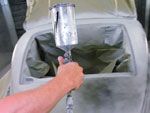
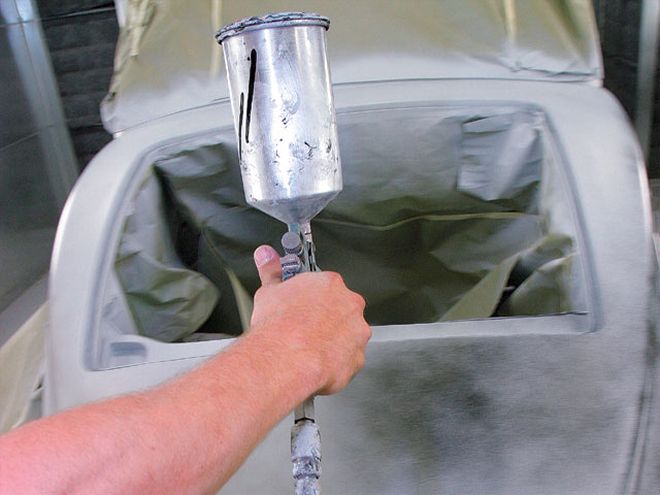
When Editor Kinnan laid out the plan for this paint series, he headedthis installment with these words: "There are too many options! How doyou choose primer, sealer, paint, clear, and so on?"
So we started digging--visiting the various paint companies' Web sites,talking to painters we knew, reading material tech and safety sheets,boning up on our chemistry . . . until at one point, we saw the light.There's a really easy answer to this question: Start with the color youwant. All the rest will follow.
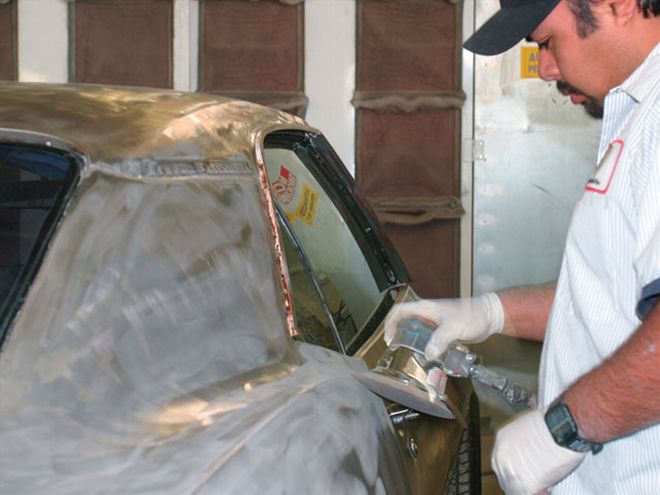 After Kinnan's '69 Camaro was soda-blasted back in Part 2 of our series"How To Strip Paint", it was rolled down to Santos Truck &Auto Repair where Arturo prepped the car for its primer coat. The firstorder of business was to blow off any remaining soda then scuff thefresh sheetmetal with 320-grit paper on a d/a. Those rust spots insidethe driprail will get a little attention with a grinder.
After Kinnan's '69 Camaro was soda-blasted back in Part 2 of our series"How To Strip Paint", it was rolled down to Santos Truck &Auto Repair where Arturo prepped the car for its primer coat. The firstorder of business was to blow off any remaining soda then scuff thefresh sheetmetal with 320-grit paper on a d/a. Those rust spots insidethe driprail will get a little attention with a grinder.
Too simple? Not when you look at it this way: Automotive refinishing isthe kind of subject about which five painters will give you 15 differentanswers to the same question. But there was 100 percent agreement amongall our sources on one key element: Stick with one company's paintsystem. Do not mix materials from different paint companies or you riskbonding, adhesion, and durability problems. If that custom-mixed paintjob starts to crack, fade, or flake off your car, none of the paintcompanies will stand behind their guarantees because they can blame theproblem on compatibility issues with the other guy's paint chemistry.
So the easy way to select your paint materials is to go through variouscompanies' paint-chip books, find the color you want for your car, thenuse that company's paint materials from the bare metal to the finaltopcoat.
Wow. This is the shortest paint installment ever. Is it lunchtime yet?
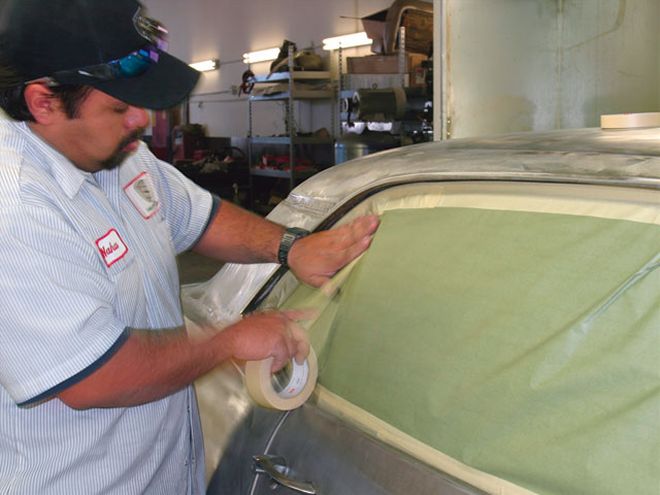 The sanding dust was blown off with an air hose, then Arturo rolled theCamaro into the booth and began masking off the parts of the car thatweren't to be primered. There's a real art to this: He laid down a thin(3/4-inch) strip of tape inside the window edges to give the adhesivethat's on the masking paper something to stick to. The edges of thepaper without adhesive were taped down with 11/2-inch tape.
The sanding dust was blown off with an air hose, then Arturo rolled theCamaro into the booth and began masking off the parts of the car thatweren't to be primered. There's a real art to this: He laid down a thin(3/4-inch) strip of tape inside the window edges to give the adhesivethat's on the masking paper something to stick to. The edges of thepaper without adhesive were taped down with 11/2-inch tape.
The Cookie Theory
OK, so maybe a little more detail is in order. For instance, why can'tyou mix paints from different companies? Paint is paint, right?
Well, no. While none of the paint manufacturers wanted to divulgeproprietary information about the chemical makeups of their products,David McConnaughey from PPG's training department put it in terms evenwe could understand.
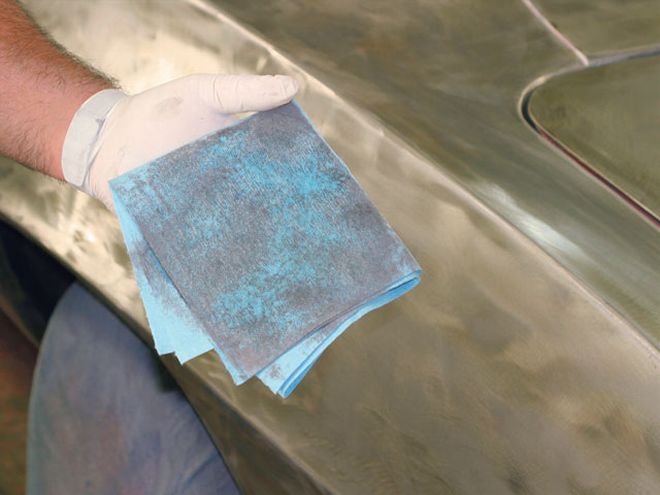 Just before painting, he wiped the car one last time with lacquerthinner to remove any remaining dirt, oil, grease, or other debris. Thiscar had been soda-blasted, washed, vacuumed, blown off (twice), scuffed,and blown off a third time, yet there was still this much dirt on themetal. Ensuring the surface is clean is imperative to this job's successso contaminants don't come up from the metal and ruin the new paint.
Just before painting, he wiped the car one last time with lacquerthinner to remove any remaining dirt, oil, grease, or other debris. Thiscar had been soda-blasted, washed, vacuumed, blown off (twice), scuffed,and blown off a third time, yet there was still this much dirt on themetal. Ensuring the surface is clean is imperative to this job's successso contaminants don't come up from the metal and ruin the new paint.
"It's like buying Chips Ahoy or Mrs. Field's. They're both chocolatechip cookies, but they taste dramatically different. That's because theingredients that go into their recipes may be similar, but they're useddifferently."
Put into the context of paint, "We make a whole range of products you'llneed from the bare metal up, and we've tested all our products forcompatibility with each other," McConnaughey explained. "If you use themproperly, we can guarantee they'll work. We know our primer/surfacerwill stick to our etching primer, that our basecoat color will stick toour primer, and that our clearcoat will stick to our basecoat. Thechemistries are all compatible. If you use one company's etching primerand someone else's high-build, someone else's sealer, another'sbasecoat, and so on, we can't guarantee that all those resintechnologies will stick together.
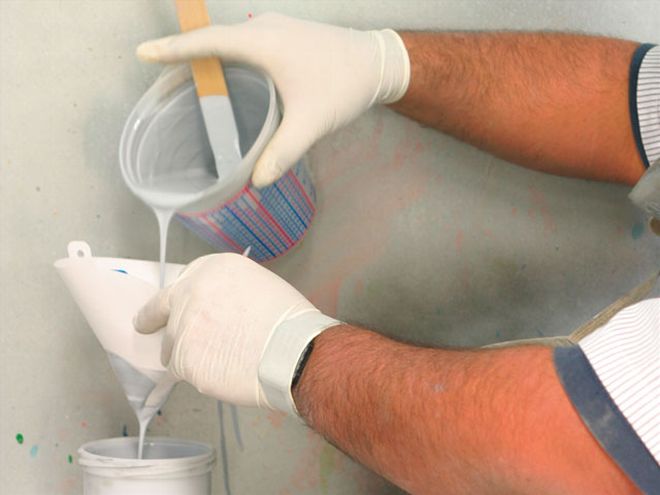 The car was primed with PCL Poly Primer, a high-fill polyesterprimer/surfacer. Arturo added some lacquer thinner to the paint alongwith its hardener to improve its flow from the gun.
The car was primed with PCL Poly Primer, a high-fill polyesterprimer/surfacer. Arturo added some lacquer thinner to the paint alongwith its hardener to improve its flow from the gun.
"Unfortunately, a lot of people buy paint based on price alone, and thatwill lead them to buying a mix of products," McConnaughey continued."Then if the product falls off in a big sheet, which company do you goback to with a claim? When you're using one system, if you have afailure, you can talk to one person."
Yet adhesion is just one reason you want the various paint layers to becompatible, said Brian Lynch, training manager for House of Kolor (HoK)."A migration of solvent occurs between layers of paint. We depend onthat for adhesion, since one hard shell on top of another won't adhere.But some of our colors depend on that solvent migration to move pigmentsfrom one layer to another. Pigment can soak up into the clearcoat to geta custom color. They're designed to interact with one another inpredictable ways."
Lynch also pointed out a fundamental difference between HoK paints andthose from companies whose main business is with the vastcollision-repair industry. The restoration of a factory paint job"typically won't be more than 5 to 7 mils thick," he said. A HoK paintjob, particularly one with special effects like candies, mica, or pearl,could be as much as 10 to 15 mils thick, "so the foundation has to bethat much more stable."
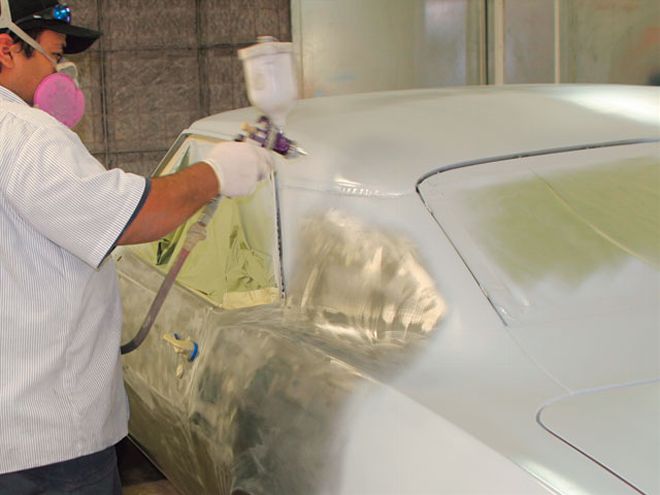 Arturo started spraying from the roof and worked down, painting firstthe passenger side of the car, then the driver side. He had to stop acouple of times to fill the gun's cup, but in just a few minutes, he hadcovered the Camaro--twice--with the high-fill primer.
Arturo started spraying from the roof and worked down, painting firstthe passenger side of the car, then the driver side. He had to stop acouple of times to fill the gun's cup, but in just a few minutes, he hadcovered the Camaro--twice--with the high-fill primer.
HoK recommends using epoxy primers "for their superior corrosionresistance and adhesion," Lynch said. "They're not fast; their next-daydry time isn't appropriate for the collision business. But they work ina custom paint application."
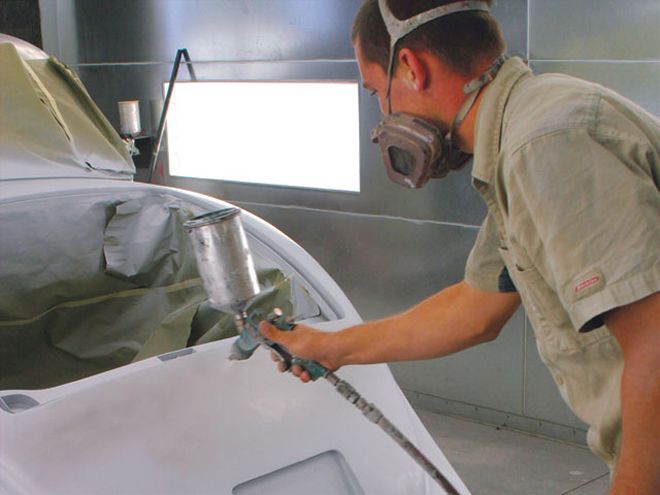 We moved to Tim Beard's Hot Rod Restoration shop, where he demonstratedhis block-sanding technique on a '35 Ford coupe, the same car we usedlast month to illustrate panel fit ("Get it Straight," Sept. '06). NickCrow shot a thin guidecoat over the car, which had already been coveredwith a high-fill polyester primer. Many painters shoot the guidecoat outof a rattle can, but because of the big area to be covered, Crow sprayeda mist of DuPont Chroma 1 black out of his gun.
We moved to Tim Beard's Hot Rod Restoration shop, where he demonstratedhis block-sanding technique on a '35 Ford coupe, the same car we usedlast month to illustrate panel fit ("Get it Straight," Sept. '06). NickCrow shot a thin guidecoat over the car, which had already been coveredwith a high-fill polyester primer. Many painters shoot the guidecoat outof a rattle can, but because of the big area to be covered, Crow sprayeda mist of DuPont Chroma 1 black out of his gun.
Primer Basics
"Even the first primer you put onto bare metal can potentially affectthe gloss of the final layer," Lynch said. Pulling out an analogy almostas effective as McConnaughey's cookies, he said, "If you were going tobuild a blower motor, you'd literally start down at the crankshaft,wouldn't you? You wouldn't put a stock crank in a supercharged engine."Yet there are almost as many different kinds of primer as there aretopcoats. How do you choose what to use? It all depends on the conditionof the surface you're painting.
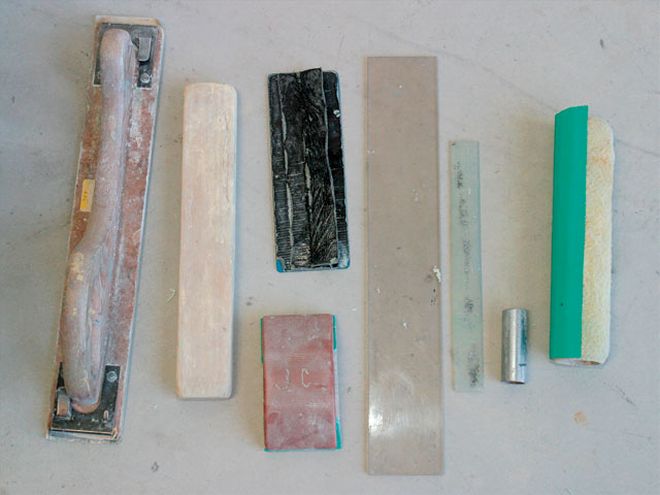 Sanding blocks take all forms, from dedicated tools sold by Eastwood andother supply companies to homemade devices such as we found in Beard'sshop. From left: a board sander, a balsa-wood block, a Plexiglas scrapcovered in duct tape to give it a handle with a rubber sanding blockbelow it, two more Plex scraps (different widths and thicknesses), asocket, and a paint roller.
Sanding blocks take all forms, from dedicated tools sold by Eastwood andother supply companies to homemade devices such as we found in Beard'sshop. From left: a board sander, a balsa-wood block, a Plexiglas scrapcovered in duct tape to give it a handle with a rubber sanding blockbelow it, two more Plex scraps (different widths and thicknesses), asocket, and a paint roller.
For example, if you're starting with bare metal, some painters recommendputting a coat of etching primer on the sheetmetal before anything else.It puts a layer of corrosion resistance on the metal and helps promoteadhesion with the layer of paint to follow.
Other painters don't use the etching primer and instead prefer an epoxyprimer as the first coat on bare metal. According to HoK, it should beone or the other, but not both, since epoxy primer doesn't react well toetching primer. "The paint will lift off before you're even done withthe job," Lynch said.
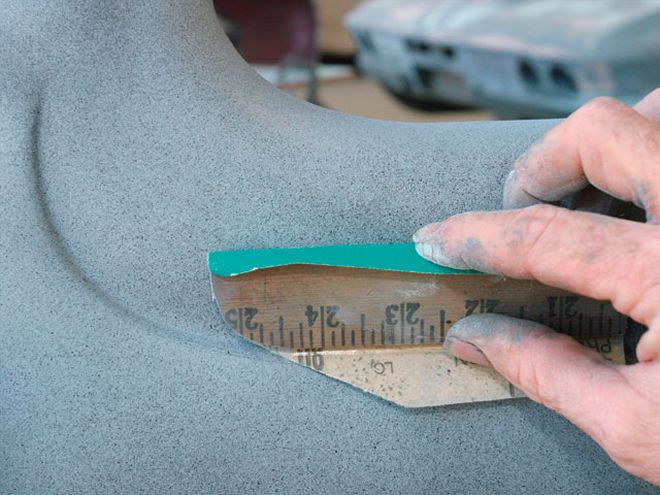 Another homemade sanding block is this yardstick, which was trimmed tofit into crannies like this door beltline. If you don't pay attention tostyling lines like this and other sharp edges, the car can look "fat,"Beard said, since the paint will just fill these places. Don't make thesanding strokes too short, Beard warned, or you'll dig a hole.
Another homemade sanding block is this yardstick, which was trimmed tofit into crannies like this door beltline. If you don't pay attention tostyling lines like this and other sharp edges, the car can look "fat,"Beard said, since the paint will just fill these places. Don't make thesanding strokes too short, Beard warned, or you'll dig a hole.
"An etching primer uses an acid to chemically clean and micro-etch thesurface to give a better mechanical bite on the substrate," explainedEastwood's John Sloane. "The epoxy, on the other hand, is typically atwo-part mix that gives you excellent adhesion, like applying epoxyglue."
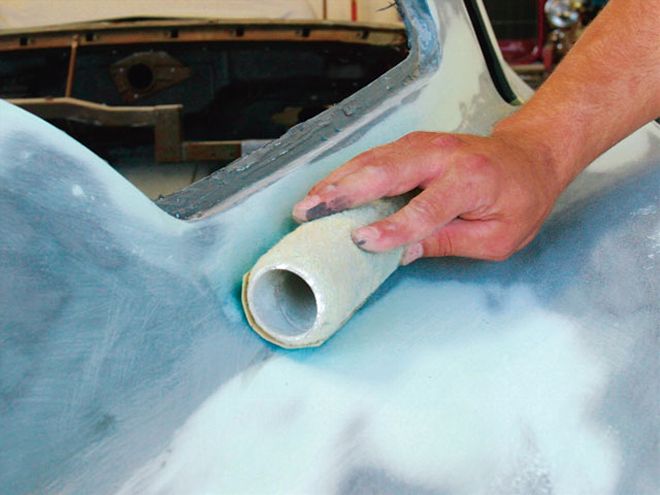 Paint roller? Yep, when covered with a sheet of adhesive sandpaper, itfits nicely into body curves, like this one on a midyear Corvette.
Paint roller? Yep, when covered with a sheet of adhesive sandpaper, itfits nicely into body curves, like this one on a midyear Corvette.
Sloane's recommendation: "If the surface is basically straight and youdon't envision applying any additional fillers, or you have bare, cleanmetal, the self etch is ideal. If, on the other hand, you may need to dosome additional filling, or if you're going to paint the car black andevery defect is going to show, then you're better off using the epoxybecause you have a substrate that can further be sanded in spots, andfiller can be added as needed."
That "additional filling" is often done with a high-fill primer (alsocalled high-build or primer surfacer). It's so named because it's arelatively thick material that will fill in small sanding scratches andother surface imperfections. It also can be built up through severallayers and then block sanded to fine-tune the panel's straightness (moreon that later).
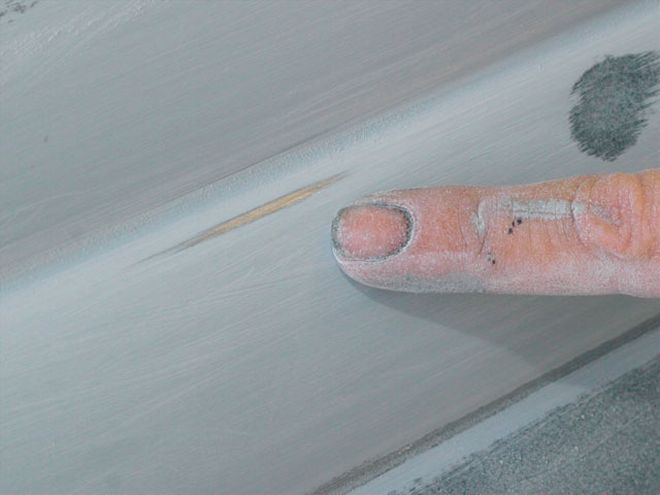 A close-up look at the low spot reveals just how low it is: The shinystreak Beard is pointing to is bare metal.
A close-up look at the low spot reveals just how low it is: The shinystreak Beard is pointing to is bare metal.
High-fill primers are made typically from polyester, urethane, or epoxy.Polyester creates the highest build of the three, as it's nearly likespraying body filler onto the car. Some painters, though, likeFastLane's Dave Lane, don't like the polyester primers "because theydon't seem as flexible as urethane. They do fill real well, though, andcan speed up the process if you choose to use them." A polyester primeris porous, though, so it should be dry-sanded only.
Once the filling and blocking process is complete, PPG's McConnaugheyrecommends finishing the primer job with a coat of sealer. "Sealersaren't necessarily required; many surfacers do double duty as sealer andsurfacer. But it's a good insurance policy to help prevent things fromgoing wrong, like solvents moving down from the topcoats to the metal.Sealers also help against stone chipping, cracking, crazing, and theyhelp hold the topcoats to undercoats."
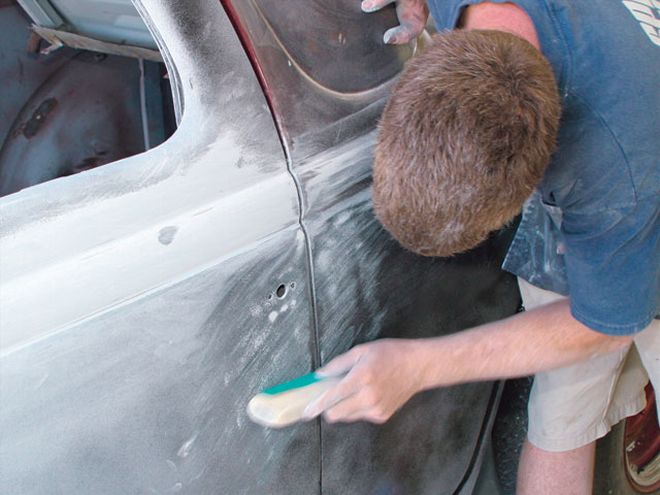 Beard uses his balsa block to sand the section where the door andquarter-panel meet. The edge of the door (where metal was added in thelast installment) is high, but the area right next to it is low--see howthe guidecoat is darker on either side of the gap than it is fartheracross the panel?
Beard uses his balsa block to sand the section where the door andquarter-panel meet. The edge of the door (where metal was added in thelast installment) is high, but the area right next to it is low--see howthe guidecoat is darker on either side of the gap than it is fartheracross the panel?
A sealer is also a good idea if your paint project started not at baremetal, but with a scuffing of a good-quality OE finish. "What that willdo is prevent any interaction between the OE finish and the solventsystem of what you're applying," Sloane said. "There's a wide range ofOEM finishes out there, in most cases different from the liquid paintsthat you buy. You want to safeguard against any possible interactionthat could cause a lifting condition or could shorten the paint'slong-term durability."
Color--Finally!
And now the moment you've all been waiting for--the actual applicationof color! Wait, no, not yet, we're not spraying color until next month.Sorry. Before you get out the gun, though, you have to decide on thekind of paint you're using.
If you've gone with the hand-the-paint-chip-to-your-painter route thatwe mentioned at the beginning of the article, all the followingdecisions are made for you. But this info may still come in handy soyou'll know what your painter is using. And the comments we got fromvarious painters will certainly be food for thought when you do discussyour project with your hired gun.
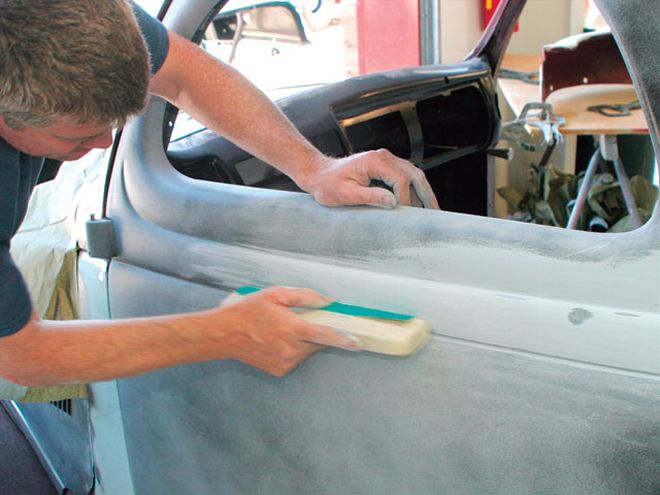 One of Beard's favorite sanding blocks is this hunk of balsa wood. It'slight, yet rigid enough to give him a clean edge. Beard favors cuttingthe guidecoat and primer with 80-grit to start, then working up to150-grit. After just a couple of minutes of sanding with the coarsepaper, a low spot is already appearing in the door (slightly above andto the right of the crease he's sanding).
One of Beard's favorite sanding blocks is this hunk of balsa wood. It'slight, yet rigid enough to give him a clean edge. Beard favors cuttingthe guidecoat and primer with 80-grit to start, then working up to150-grit. After just a couple of minutes of sanding with the coarsepaper, a low spot is already appearing in the door (slightly above andto the right of the crease he's sanding).
We'll shortcut the usual "History of Paint" portion of this story downto this: Lacquers are still available for those who need the old-schoolcoating for restoration purposes, and they're considered the easiestpaints for a beginner to use, since if you don't like the results youcan simply wipe the paint off with a solvent-coated rag and start over.But that characteristic makes lacquer less durable than other paints,since solvent--found in all sorts of stuff, from gasoline to birddroppings--will mar the finish. Lacquers are also illegal to use in manyareas because of their detrimental effect on air quality (see thesidebar "VOC--No Joke").
Enamel, popular in the '70s, is also still available if you're lookingfor a coating that's inexpensive and durable. And thick; a couple ofcoats of enamel provides the same film thickness as the fabled 20 coatsof hand-rubbed lacquer.
But really, urethane is the first choice of today's custom painters. Itbonds well, provides excellent protection from ultraviolet (UV) rays, isdurable, and offers a vibrance of color not found in the older-stylepaints. Plus, it was the introduction of urethane paints in the '80sthat brought about the two-stage, basecoat/clearcoat paint system soprevalent today.
With the two-stage system, a pigmented basecoat (or two) is covered witha clear or slightly tinted topcoat that gives the base its gloss and UVprotection. The alternative single-stage paint contains the gloss and UVprotectants in the same material as the pigment.
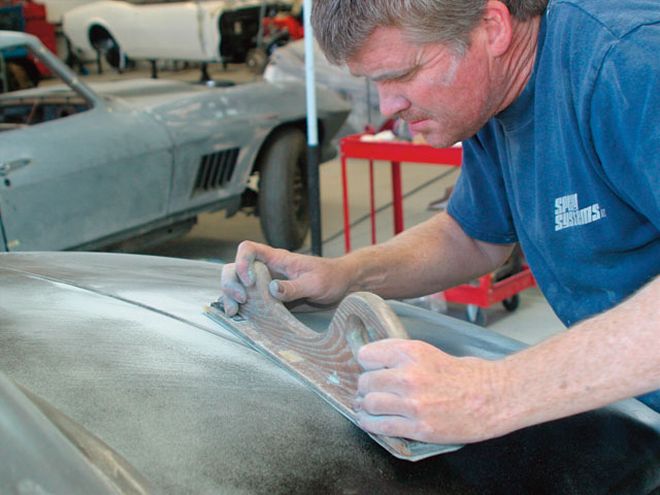 For broad, flat areas, Beard sands using the long board.
For broad, flat areas, Beard sands using the long board.
Each system has its fans and detractors. Tim Beard of Hot RodRestorations, for example, shoots all his solid colors with single-stagepaint. Clearcoat gives the paint a higher gloss than a single-stage "butnot as much depth. With a single-stage, I can put on five coats,wet-sand with 500-grit, fix any imperfections, then spray on five morecoats." Two-stage paint has a fairly short window of time between theapplication of the final basecoat and when the clear has to go on. "Ihave time to shoot maybe two coats of base before I have to clear,"Beard said.
John Morrow of Johns Customz & Performance added, "Single-stage iseasier to spray, and you get more brilliance in the color, since thepigments are closer to the surface."
But Morrow acknowledges that the UV protection offered by a clearcoathelps to keep the pigment looking fresh longer. And pretty much all thepainters we spoke to agreed that the two-stage system is best for acouple of reasons if you have special effects in the paint such asmetalflake, candy, mica, or pearl. The UV protectants in the clearcoatkeep the effects from burning or mottling, and when it's time to do thefinal sanding, it's better to sand over clearcoat than directly on thespecial-effects paint. Otherwise those effects could shift, causingweird--and undesirable --results.
Whose Paint?
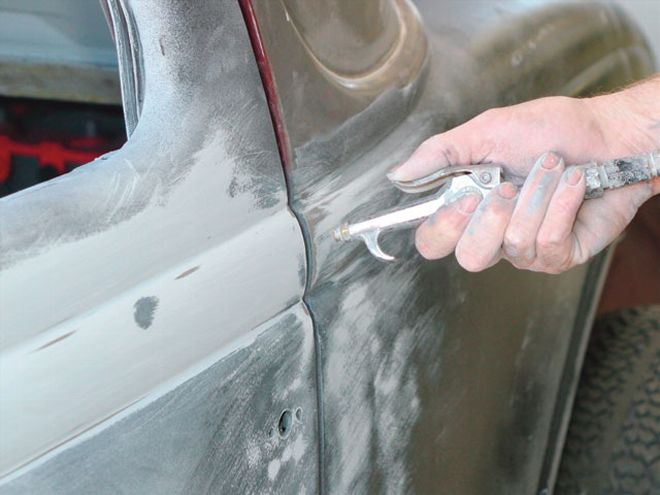 When it's time to work on the door's low spot, Beard cleans the areathoroughly by wiping it and blowing it off. Otherwise the sanding dustcould contaminate the fix.
When it's time to work on the door's low spot, Beard cleans the areathoroughly by wiping it and blowing it off. Otherwise the sanding dustcould contaminate the fix.
We thought it would be interesting to poll several painters and ask themwhich paint system they use and why.
Tim Beard, Hot Rod Restorations: "I'm a PPG guy. I know the paints,they're user-friendly, and I like the colors. I know how to mix them,their drying time, and how to set up my gun the same way every time. Youhave to have consistency in this business. I do like House of Kolor'spearls and candies, and yes, I mix those with PPG clears. But I'velearned what I can mix over years of experience--I don't mix hardenersor reducers--and I know PPG clear will work over a House of Kolor base."
Craig Hopkins, Goodmark Industries: "DuPont is easy to spray, PPG is toosoft. I'm a House of Kolor convert. It's show-car paint. Way less grainyin the clear, way easier to sand and polish. Other [paints] are gearedto the collision industry; shoot 'em out and have an OEM look to [the]car."
Dave Lane, FastLane Rod Shop: "I really prefer DuPont. I have reallybeen pleased with their products since I started using them. Every carI've done since '98 has been with DuPont, and I've never had anyproblems. I have been very happy with how their clears lay down and howwell they can be sanded and buffed. You can really get a good, flatfinish."
John Morrow, Johns Customz & Performance: "We use DuPont. The durabilityof the paint is better. From what we've encountered with other paints,the colors are more vibrant. And DuPont seems to use more solids in itspigments, so the paint covers faster."
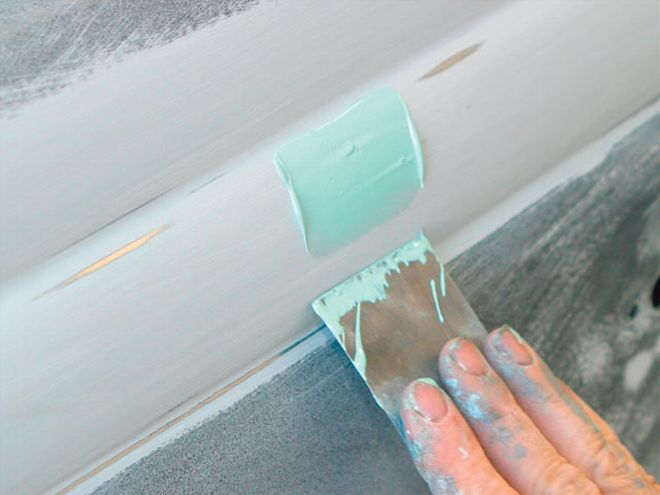 Beard fills the spot with Evercoat Metal Glaze, a polyester finishingand blending putty. It mixes and applies much like body filler, but it'sthinner. As such, it sets up faster, so you have to work quickly.Beard's spreader of choice is made from spring steel. It's flexible likea plastic paddle but won't gouge or warp.
Beard fills the spot with Evercoat Metal Glaze, a polyester finishingand blending putty. It mixes and applies much like body filler, but it'sthinner. As such, it sets up faster, so you have to work quickly.Beard's spreader of choice is made from spring steel. It's flexible likea plastic paddle but won't gouge or warp.
As different as their preferences were, they all had this thought incommon: Don't cheap out on materials. "You've spent so much time andmoney getting it this far, stick with high-quality paint," Beard said.
"Each company has a variety of paint qualities, but the cheaper paintsdon't last," Morrow said. "You definitely get what you pay for."
VOC--No Joke
The acronym stands for volatile organic compounds, which are essentiallycarbon-based pollutants contained in paint materials. There are nationaland local regulations limiting the VOC content in paint, and it'simportant to know what's allowed in your area. (One of the circumstancesthat has virtually killed off the use of lacquer is its high VOC contentand resulting prohibition in air-quality-sensitive areas.)
The VOC in paint is typically expressed on either pounds per gallon orgrams per liter and can be found in the paint's material safety datasheet.
Some manufacturers will offer different versions of a paint to meet thecountry's varying VOC regulations. House of Kolor's Ko-Seal urethaneprimer/sealer, for example, is available in two series: one with a VOCcontent that meets national regulations, the other that meets the muchstricter standards of the South Coast (California) Air QualityManagement District.
Paint Additives
Ambient conditions and the substrate being covered may require somealterations to the paint's basic characteristics. Here's what'stypically added to paint and why:
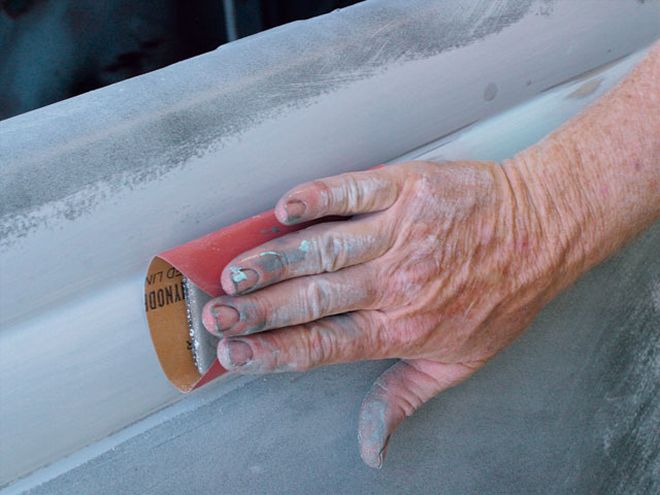 Once the putty is dry, Beard hits it with 80-grit paper on a smallsanding stick, then he'll finish the patch by scuffing it with 150-griton a soft pad, which cuts down any gouges or choppiness left by the80-grit. Note that he's careful to lift his fingertips off the pad sothey don't gouge the metal or leave low spots of their own.
Once the putty is dry, Beard hits it with 80-grit paper on a smallsanding stick, then he'll finish the patch by scuffing it with 150-griton a soft pad, which cuts down any gouges or choppiness left by the80-grit. Note that he's careful to lift his fingertips off the pad sothey don't gouge the metal or leave low spots of their own.
Catalyst: Promotes the cross-linking (the chemical "drying," orcuring) of the paint for durability and adhesion.
Reducer: Changes the viscosity of the paint to aid flow out ofthe spray gun. Reducers are typically rated for use in specific ambientconditions; PPG offers one reducer for ambient temperatures of between65 and 75 degrees, another for between 75 and 85 degrees, and so on.Said PPG's David McConnaughey, "The hotter it is, the slower you need."
Accelerator: Used to shorten the paint's drying time. "If yourclearcoat takes 16 hours to dry, that's a lot of time for bugs, dirt,and other junk to land on the paint and mess it up," McConnaughey said."Or, if you're spraying in Minneapolis in January, that 16-hour dry timemight go up to 20. Accelerator brings the dry time back down to areasonable amount." Accelerators should only be used when the paint isdrying in the air and not in a bake booth, he added, as the combinationof the two may cause the paint to cure too quickly.
Retarder: The opposite of an accelerator; slows the drying time.
Flex additive: Added to undercoats or clearcoats when painting aplastic part off the vehicle, it helps the paint film stay flexibleduring reinstallation of the part.
Block-Sanding
Between the primer and the topcoats is this critically important --andincredibly time-consuming--step. "I may have 500 hours in painting acar," Beard said. "And almost half of the whole process, 200 hours orso, is spent block-sanding." Before he's ready to spray on color, Beardmay have block-sanded a car three or four times.
Why all this attention to detail? This is really your last chance to getthe body panels as flat, straight, and perfect as possible. "It's farcheaper and easier to apply additional high-build primer than to applyadditional color coats, especially if you're using specialty paints likeflip-flop coats, pearls, and so on," Sloane said.
There are several secrets to effective block-sanding. Most important isthe guidecoat: a fine mist of paint in a color that contrasts sharplywith the primer that will reveal high and low spots in the bodywork whensanded. "Don't trust your eyes; they'll let you down every time," Morrowadvised.
Opinions differ on how coarse the paper should be for block-sanding.Morrow doesn't want anything too harsh, and he doesn't want to breakthrough the sealer down to bare metal. So he uses 150- to 220-gritpaper. Beard, on the other hand, wants to see bare metal. "I've put onso much mil thickness that I can break the rules. I want to go to baremetal to truly see the extent of the low and high spots. Just taking offthe guidecoat isn't enough." So he'll start with 80-grit, which givesthe primer a lot of tooth to hold any filler or putty needed forrepairs, and works up to 150-grit.
What you put the paper on is important, too. For long, flat surfaces,you want a long sanding board to make as much of the area asconsistently straight as possible. But really, few automotive surfacesare barn-door flat; most have some sort of curve to them. To accommodatethat curve, use a board with some flex to it. Eastwood and othersuppliers sell flexible sanding blocks and boards; or you can makesanding boards, as several of our painters have done, from items foundaround the shop like yardsticks, scrap pieces of Plexiglas, even paintrollers.
The photos that accompany our story this month show some of the basicsof primering a car and going through the block-sanding process. Nextmonth--color!
Tools You'll Need
* Primer/sealer: To prep the metal prior to paint.
* Spraygun: To apply primer. We'll get more into spray techniques in ournext installment. Shown here is Sharpe's Cobalt HVLP gun from Eastwood.
* Masking tape/paper: To cover the portions of the car you don'twant covered in primer.
* Sanding boards: Paint supply houses,including Eastwood, offer a number of sanding boards made in a number oflengths and from various materials to be either flexible or rigid,depending on what you're sanding.
* Sandpaper: Anywhere from 80-to 220-grit for block-sanding, depending on how hard you want to cut thematerial. Self-adhesive paper will stick to a variety of boards.
* Guidecoat: Eastwood offers a dedicated guidecoat paint fromEvercoat, but just about any paint will do, provided it contrasts withyour primer.
* Glazing putty or body filler: To fix those peskylow spots.
* Nitrile gloves: To keep toxic paint--and freshlysanded toxic paint dust--off your skin.